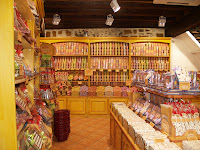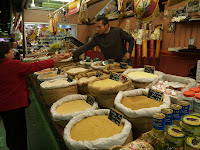
Linn and I have been trying to make the most of our Christmas break here in France. He finished classes on Friday and I had my final exam the Monday before, we’ve been celebrating ever since. We met up with Bruno and Rachel Friday evening at our favorite hang out the “beer shop,” for yummy beer and quality conversation. One round later we had planned our first day of vacation. The next day the four of us took a train to Carcassonne an hour and twenty- minute train ride from Montpellier.

We descended from the train at 10am and began our walk through the “lower city.” They had a huge farmers market happening with fruits, vegetables, meats, cheeses, and flowers. It stretched throughout many city blocks and around the main square. We picked up some things for a picnic lunch and made our way to the crown jewel of Carcassonne. Atop the hill above the “lower city” is the “old city” a double- walled medieval city that still stands and is inhabited to this day. Of course this is a large tourist area so there are lots of souvenir stores, local specialty retailers and restaurants. One of the tourist spots “La Cure Gourmande” is a gourmet sweet shop. They had 20 different varieties of biscuits or cookies. They had a long wall of different types of artisanal caramels and a huge table of different flavors of nougat. Nougat seems to be one of the sweets of choice here in the South. The best thing about this shop was how beautiful it was. Their packaging was all different bags or tins with colorful, vintage looking prints. Apparently, the company started in the 80’s and is not unique to Carcassonne but everything was very pretty and looked like a revitalized historic gem.



The coolest thing about this “Old City” was the juxtaposition of old and new. Walking out of modern shops where I had just used my credit card and towering over me is this 1,000 year- old structure. It made me realize how lucky I am to be here and to be witnessing one of the best examples of a medieval city in all of Europe and the best in Southern France. Of course there have been lots of renovations and the buildings are not original so it is impossible to feel what it was like originally but it was still amazing to see the old architecture and to pretend what it may have been like. The exterior ring walls and towers are original dating from the 11th century. However, all of the interior buildings were built much later, probably from the 1800’s when a lot of restoration and renovation took place. Today approximately 120 people live and work in this ancient city. If ever passing through Carcassonne, one must stop, you. After an amusing walk back through the city streets we made it back to the train station. The four of us took the same train to Narbonne where they got off to meet up with his family for the Holidays and where we switched trains to get back to Montpellier. Carcassonne was our second little day trip out of Montpellier and it was wonderful. The four of us had a great day touring this new city.
After a couple days in Montpellier with not much to do but learn French we decided to catch a train to Nimes. Only a forty- minute ride from Montpellier but totally worth a day trip! Nimes is home to several important pieces of architecture still standing or partially standing to this day. Their claim to fame is the invention of denim. I believe in the 1700s they had invented this very durable fabric originally used for ships sails. The called the cloth of Nimes which translates to tissu de Nimes, de Nimes… deNimes… denim! I didn’t see much boasting that invention but I’d read about it online several times. The architectural marvels: They have an Arena that dates from the end of the 1st century. It is similar to the Coliseum in Rome though not as large and has been is frequently used to this day and thus frequently repaired. It was interesting from the outside and from recent photographs it looks like a modern concert venue inside. They’ve installed a ring of bleacher seating and it is still used to this day for concerts and bull fights.



Another important building is the Maison Carrée one of the best preserved Roman temples anywhere in the former territory of the Roman Empire. It was built early in the first century and has been used as many different things until becoming a museum in 1823. Most importantly it became a church in the 4th century which prevented it from being demolished when many former Roman temples had been. Today it is a museum that offers it’s windowless walls to rotating exhibits and apparently there is no original decoration on the interior. We didn’t go in but I’ve read all about it in school and it was very cool to see, even if one whole side was covered with scaffolding and a billboard for the current exhibit.
We then found our way to the Fountain Gardens or Les Jardins de la Fountaine that I’d read about online. The garden was developed in the 17th century and was built to showcase roman ruins and to incorporate the natural spring and help get water to more of the city. One partial building remains on the property from the Augusteum or the sanctuary for the emperors and their families. The Temple of Diane was probably used for celebrations for the families. The park is beautiful and well maintained. The fountain is over a natural spring and is pretty powerful. The connecting canals were originally designed to get water to more of the city from the spring. Today they are partially functional, partly aesthetic. The gardens of mostly trees and greenery this time of year climbs the large hill behind the fountain to the oldest and highest point of the city. At the top of the hill sits Le Tour Magne, which dates from the first century BC. Today it only has two of three levels and only one half of one archway of an arcade that once supported a ramp. Old, old, old and one could walk right up to it and kiss it if they so pleased.




Nimes was a great city and also one to visit if you’re ever cruising the South of France. Now we’re off to Germany for three days and Denmark for five, we’ll be meeting up with Carolyn and Lars for the Denmark portion, we’ll be seeking great German beer during the Germany portion. We wish you all a very safe and Happy New Year!










